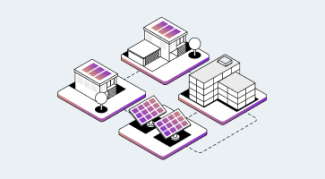

Case Study - Islandable Microgrids in Cobargo
The Energy Innovation Toolkit periodically publishes case studies of real projects for which it has provided regulatory guidance to share learnings and highlight innovations happening in the industry right now.
This case study concerns the township of Cobargo, its distributor Essential Energy and a novel microgrid proposal.
The Energy Innovation Toolkit has already helped many energy innovators to receive targeted guidance as to what is possible for their idea under current energy regulations. The guidance we provide these innovators is private to them insofar as it relates to their private IP, technical specifications and innovative technologies, but an important part of the Energy Innovation Toolkit is knowledge sharing. This case study is a summary of guidance we recently provided in response to Essential Energy – a distribution network service provider – and project proponents from the NSW town of Cobargo about a new kind of microgrid which will provide relief to residents of Cobargo and beyond and improve network stability in certain natural disasters.
Cobargo, a remote town in the south-east of New South Wales (NSW) experienced an extended power outage after the 2019/20 bushfires burnt electrical infrastructure across the region. Without power, the town’s water supply, sewerage and petrol pumps were not operational. No battery backup for telephone and internet services (including banking/EFTPOS) meant these services were also quickly unavailable and many homes and businesses were affected by the power outages for months.
As a result of this experience, Cobargo and District Energy Transition (CaDET) hopes to build an electricity microgrid that allows a portion of the town to continue to operate, using locally stored and generated electricity (island mode), when the network connection to the interconnected system (‘the grid’) is offline.
CaDET engaged ITP Renewables, a renewable energy consulting group, to undertake a microgrid feasibility study. ITP Renewables, who received a grant from the Australian Government’s Regional and Remote Communities Reliability Fund, worked with CaDET to prepare options for developing a local microgrid. Essential Energy, who supply power as the Distribution Network Service Provider (DNSP) for Cobargo, were also engaged to assist in identifying network requirements and interpreting the regulatory framework requirements.
The microgrid in this hypothetical scenario is intended to operate in “island mode” only when the network connection is offline and would otherwise remain connected to the grid.
The guidance we gave is intended to provide an indicative explanation at a staff level of the current regulatory framework and provides the starting considerations for any potential islandable microgrid trial to consider. Each situation is different and how it will be regulated depends on how the individual microgrid is implemented and operated. It is worth noting also that the below guidance does not consider the role of and impact on other entities such as retailers, and this will need to be addressed at a future stage.
Regulatory guidance being sought - what is an "islandable microgrid"?
There is no definition of a ‘microgrid’ in the National Electricity Law (NEL) or National Electricity Rules (NER) or state and territory energy laws. As such, the term is often used by different parties to refer to different things, including isolated standalone power systems (SAPS), embedded networks with distributed energy resources (DER) and standard connections with DER. In the context of this article, we will use the term ‘islandable microgrid’ to refer to electricity networks that can be isolated and operated independently of the interconnected electricity system (the ‘grid’) but retain connection with the grid and interface with the wholesale electricity market. An islandable microgrid differs from a SAPS in that a SAPS does not have any physical connection to the grid.
The proponents sought regulatory guidance as to how an islandable microgrid (which is at times connected to the grid, and at other times not) fits within current national regulatory frameworks. The questions to the EIT raised potential gaps in the existing national energy laws and regulations (collectively, the Energy Rules). Our response considered whether these gaps exist and if they do, what methods might be available to resolve these in order to implement an islandable microgrid.
What is possible now? What might need to change?
As the proposed microgrid is considered to form part of the interconnected national electricity system, generation assets and load connected to the microgrid would be treated as connected to the national grid for periods when the microgrid is connected to the National Energy Market (NEM) and periods when the microgrid is islanded.
In approaching the EIT, the proponents identified a number of potential issues which would have to be considered for any trial of an islandable microgrid to take place. These included:
- Settlement anomalies - when a microgrid is islanded it is disconnected from the main grid, but electricity is still being provided to on-market meters; this will result in settlement anomalies.
- Tariffs - network tariffs which work for the main grid or for SAPS won't necessarily be appropriate here, so it was possible new tariffs would need to be considered.
- Privately owned assets – responsibility for maintaining privately owned assets such as rooftop solar PV connected to the microgrid.
- Reliability of supply – responsibility for sufficient generation and storage, and reliability standards during islanding, including questions concerning DNSP-owned generation assets.
- System operation – responsibility for operation of the microgrid during islanding, protection and performance requirements.
Detailed consideration of these issue is set out below, but the guidance provided by the EIT was that none of the considerations above presented insurmountable issues which would prevent the implementation of islandable microgrid technology. A detailed and technical proposal would need to be developed before an assessment could be made on whether a physical trial would be able to be accommodated within the Energy Rules, or whether the initiative should progress in the direction of a trial or rule change request.
Service Delivery Considerations
When the microgrid is disconnected from the grid, customers located in the microgrid would continue to be recognised as being grid-connected NEM customers in market systems, and generators connected to the microgrid would be able to access NEM settlement prices and ancillary services.
As a result, operating the microgrid in island mode would result in market anomalies, as energy would continue to flow through metered connection points and metering data would be provided to AEMO and relevant market participants. Market settlement would still occur using the prevailing spot price.
Staff at AEMO (as project partners of the EIT) have considered the general proposal of islandable microgrids. While no further consideration can be given in the absence of a detailed technical and operational plan), it will be given in the future once such a plan exists with a view to either mitigating the impact of settlement anomalies or considering alternative settlement processes which may resolve the matter. This would, in itself, require significant alternative processes and regulatory conditions to be imposed. We encourage all proponents who are looking to implement a project of this nature to reach out to the Energy Innovation Toolkit and discuss opportunities to proceed.
For reasons similar to those set out above for settlement anomalies, tariff anomalies remain a possibility under an islandable microgrid trial. These might look something like network operators recovering network connection charges from customers that are not connected to the upstream distribution and transmission networks and the application of AEMO market settlement processes that include market losses.
Based on the information provided, such anomalies are expected to be minor and the AER Network Tariff team is willing to discuss ways to mitigate anomalies under future implementation of this proposal.
System operations, responsibility, reliability and ownership considerations
The establishment of sufficient generation, storage capacity and control systems for the management of supply and demand would be the responsibility of the party seeking to establish the islandable microgrid, with the market interface under the management of market participants.
In Cobargo, proponents are contemplating the installation of a solar farm with generation up to 5MW. This generation would create supply sufficient to meet the demands of most public services in the town and also some private residences. A generator of this size would attract certain regulatory obligations, and while compliance with these would have to be managed, proposals, at a minimum, would need to present a reliable, safe and secure generation model. In comparison, reliance on generating infrastructure privately owned by non-market participants (e.g. individual rooftop solar and private batteries) could raise significant reliability and safety concerns for a scheme.
The guidance we gave in relation to control and or responsibility of the system during islanding mode, is that if the microgrid is to be considered part of the interconnected grid at all times, existing obligations would remain with the DNSP as it is a part of a DNSP’s network and must be regulated in the same way as it otherwise would if it were part of the interconnected system.
DNSPs must apply for a ring-fencing waiver to own and operate generation assets. Whether such a waiver is appropriate would depend on the circumstances of the proposed trial.
When a generator is connected by a DNSP for emergency support it would not normally have wholesale market metering. If the connection is unmetered, then the impact of injecting the generated energy into the system is to reduce unaccounted for energy losses and thus is likely to reduce loss allocations to energy retailers serving customers in the broader settlement area. For short-duration outages (e.g., several hours), with very small volumes of energy injected, the distortionary effect is typically non-material.
Next steps - what needs to happen now
The proponents have met with the EIT and its project partners to discuss the accommodation of islandable microgrids under the current regulatory framework. Through the work undertaken by the EIT and its project partners we have identified some of the next steps for the proponents. This includes creating more detailed operational and technical plans for the microgrid, and we will continue to work with them as they progress their project – whether that be towards a desktop trial, a formal sandboxing trial through the EIT or making a formal rule change request.
As part of the guidance we gave to the proponents, we included what additional information and or clarification we would require from any proponent of an islandable microgrids trial in order to consider the matter further. This information includes:
-
the technical mechanism to be deployed to island and to reconnect to the interconnected system;
-
roles and responsibilities related to the islanding and reconnection of the microgrid;
-
the desired outcomes when islanded to affected market participants and customers.
-
how the interconnected system might technically operate;
-
the implications for NEM metering operations (in particular for metering data providers);
-
the potential implications for retail market processes, such as:
-
prudential management;
-
customer switching;
-
application of the National Energy Retail Rules (including provisions such as life support/medically dependent customer connections); and
-
Retailer of Last Resort processes.
-
-
further consideration of the operation of the retail market would also be required, including:
-
consideration of visibility to all affected participants of the potential for islanding;
-
notification upon islanding and upon re-establishment of network connection;
-
metering arrangements, including operation, installation, and maintenance; and
-
management of connection point standing data.
-

